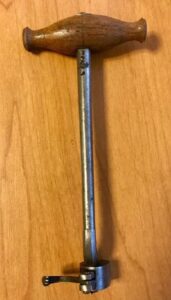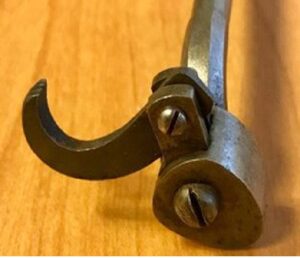Dental Keys
by Kate Lenart, MA
Like the wood-handled one pictured here (see Figures 1 and 2), dental keys were a popular tool for extractions during the 18th and 19th centuries. Dentists would insert these instruments, also known as “tooth keys,” into the mouths of their patients, secure the tooth to be removed, and then rotate the key to extract. Several dentists modified the key’s design, resulting in several versions of the tool(1). Patented in 1859 by B.F. Killiam, this design features a movable bolster with a screw that could control the movement of the claw.
Dentist and historian John M. Hyson, Jr. posited that dental keys caused more accidents and injuries than all other contemporary extraction instruments combined(2). Hyson accounted for the continued use of the tool by identifying it as the quickest method of extraction available during its time.
During the 19th century, however, advancement in the design of forceps led to the decline of the dental key. Newer forceps featured beaks of varying sizes that matched the proportions of different types of teeth. With innovations like this available, the dental key gradually became a tool of the past.


References:
1. Colyer, F. (1951, August). A note on the dental key. Proceedings of the Royal Society of Medicine, 44(8), 652–655. PubMed https://doi.org/10.1177/003591575104400803
2. Hyson, J. M., Jr. (2005, November). The dental key: A dangerous and barbarous instrument. Journal of the History of Dentistry, 53(3), 95–96. PubMed